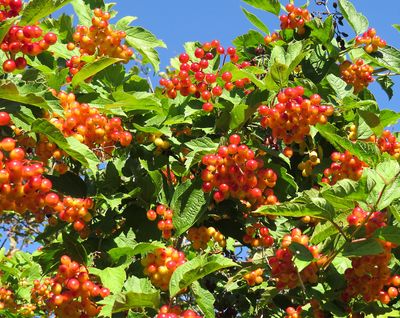In the Garden: Vibrant, hardy viburnums a year-round joy

While we gardeners love our blooming annuals and perennials, trees and shrubs provide a backdrop for the floral display throughout the season. One of the loveliest shrubs ideal for growing in the Inland Northwest is the viburnum.
If the name doesn’t ring a bell, think of all of the spring-blooming shrubs with snowball-like flowers that you see growing everywhere you look. That, my friends, is a viburnum.
This genus of shrubs is known for its hardiness, attractive and sometimes fragrant blossoms, and lovely foliage that turns color in the fall.
Snowball viburnums (V. opulus) have globular flower clusters reminiscent of large snowballs in a creamy white that change to the palest lime green imaginable. Hardy down to USDA zone 3, the plants can grow anywhere from 8 to 12 feet high. The green leaves change to a purplish-red in the fall, making it really worth its space in the garden.
Koreanspice viburnums (V. carlesii) are a favorite of mine, specifically due to the exotic fragrance of their flower heads. I first noticed them in Manito Park about 20 years ago and was enthralled with their heady scent. After identifying them in a garden book, I knew they had to be a part of my landscape. Four of them have a home right next to a garden gate, giving me plenty of opportunities to catch a whiff when they’re blooming in the spring. They are hardy down to zone 4 and grow from 4 to 6 feet in height. And yes, their fall foliage display of red and orange leaves looks stunning.
Burkwood viburnums (V. x burkwoodii) are similar in appearance to the Koreanspice so if you have difficulty locating the latter, a Burkwood is an excellent substitute. They also have attractive white flower heads with a delightful fragrance that isn’t quite as amazing as Koreanspice, but still wonderful. Burkwoods are hardy down to zone 5 and grow about 6 feet in height.
We’ve had a few American cranberry bushes (V. trilobum) in our garden for years and they are also a favorite. This Northwest native features white lacecap flowers in the spring, berries in the summer that persist well into the winter, and eye-catching red leaves in the fall. Those beautiful red berries are a favorite of birds during the winter. The cedar and Bohemian waxwings just can’t leave them alone, providing us with plenty of entertainment and photo opportunities. They can grow from 6 to 12 feet in height and are hardy down to an impressive zone 2.
One viburnum I’ve never grown but hope to have someday is the Doublefile viburnum (V. plicatum var. tomentosum). Why? Put simply, the flower heads are magnificent. They feature tiny fertile flowers surrounded by a ring of sterile white blossoms. The branches typically grow horizontally, adding interest and texture to the landscape. Hardy down to zone 5, Doublefiles grow up to 8 feet tall and put on a showy display of reddish-purple leaves in the fall.
All of these viburnums are spring-bloomers, typically during the month of May. Each requires regular watering and does best in full sun to part shade. They are deciduous in this region, meaning they’ll drop their leaves after a hard frost in the fall. Their berries, from red to black in color, provide winter interest and are an important nutrition source for birds.
If you’d like to add some structure to your garden, consider viburnums. They have so much going for them, you’ll enjoy them all year long.
Susan Mulvihill is co-author, with Pat Munts, of “Northwest Gardener’s Handbook.” Contact her at Susan@susansinthegarden.com and follow Susan on Facebook at facebook.com/susansinthegarden.